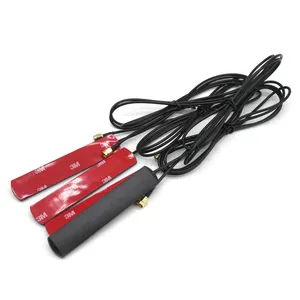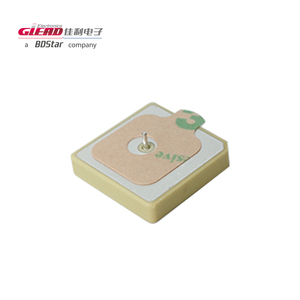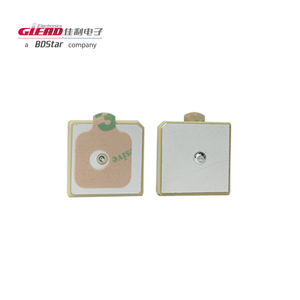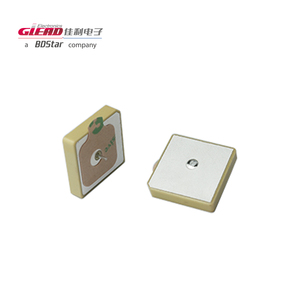(14173 products available)





































































































































































































Patch antennas are currently a class of prominent, low-profile, and easy-to-fabricate antennas. These antennas take the form of a rectangular or square patch to facilitate efficient radiation of electromagnetic waves. Such antennas are extensively used to provide cellular network connectivity in mobile phones and many other wireless gadgets. Below are common types of a patch antennast:
Standard patch antennas have dominant radiation patterns, which means they mainly radiate energy in a specific direction. Due to this property, these antennas enjoy much popularity, especially in applications that require coverage in a particular direction. Moreover, their uncomplicated fabrication process, which can involve metal on a dielectric substrate, means they can easily be integrated into diverse systems.
Square patch antennas represent one of the most basic and extensively spread configurations among patch antennas. In the square patch antenna, a square metal patch is mounted on a dielectric substrate above a conductive ground plane. This design is simple and allows for its easy introduction into various applications. Moreover, square patch antennas possess a good balance between gain and bandwidth.
Unlike square patch antennas, whose shapes differ from the basic design structure, circular patch antennas have a circular shape. This configuration improves polarization properties. This means the antenna will perform better in mobile systems where the signal direction changes continuously. Circular patch antennas can also be broad in bandwidth, which makes them suitable for applications in satellites and wireless communications.
To enhance performance parameters such as bandwidth and directionality, complex patch antennas incorporate slots, feeds, and additional patches. These antennas can, therefore, meet more application needs because they can increase efficiency, gain, and polarization.
The primary takeaway is that each patch antenna differs in performance and application suitability, given the characteristics of the extended diverse shapes and designs of the patch antennas.
Multiple materials and compositions of patch antenna assemblies are currently available on the market today. Such materials profoundly affect the performance, efficiency, and ease of fabrication.
Metal patches are further the active components of patch antennas that generate and radiate electromagnetic waves. The metals used in patch antennas include copper, gold, and aluminum. Copper enjoys much popularity due to its high electrical conductivity. It can, therefore, ensure efficient radiation. Moreover, copper is highly resilient and can effectively resist corrosion. This leads to long-term performance. While gold is the second metal with very high conductivity, it is pricey and commonly used where the antenna needs to be durable and effective.
Dielectric substrates hold the metallic patch and provide the necessary spacing from the ground plane. Usually, the selected dielectric material determines the patch antenna's operating frequency and bandwidth. Typical dielectric materials include Roger's RT/duriod, FR-4 epoxy, and Teflon. Roger's RT/duriod, for instance, offers superior thermal and electrical performance. This feature makes it suitable for high-frequency applications. FR-4 is more employed because of its cost and availability. Nevertheless, it can perform reasonably well at lower frequencies. Lastly, Teflon, with its excellent dielectric properties and stability, is commonly employed in applications that require superior performance.
The ground plane in a patch antenna is the conductive layer beneath the dielectric substrate. It provides a reference for the electromagnetic field. Most ground planes are made from copper or aluminum due to the high conductivity, just like the metal patch. However, copper has the most common application because of its conductivity and resistance to corrosion.
To sum up, the materials in patch antennas are selected depending on the performance needed, cost considerations, and the application environment. The metals used range from the conductive copper, gold, and aluminum for the metal patch to the Roger RT/duriod, Teflon, and FR-4 epoxy for the dielectric substrate and ground plane materials.
Patch antennas enjoy much utilization in modern commercial applications due to their low profile and ease of fabrication. Below are some usages of patch antennas:
In cellular networks, patch antennas have a common application because they help radio frequency communication. They can be easily embedded in mobile devices, providing substantial network connectivity for 4G and 5G ecosystems. Moreover, their compact designs mean they fit seamlessly within smartphones and IoT devices.
GPS employs a circular patch antenna to maintain precise global positioning. The circular patch can effectively handle the dynamic orientation that occurs in vehicles and portable gadgets. It helps retain signal accuracy. Broadly speaking, GPS devices incorporate these antennas for accurate location tracking and mapping.
Satellite communication systems use patch antennas to maintain signals with orbiting satellites. Such a system requires continuous communication, and patch antennas efficiently provide this service. They are compact and lightweight and fit well in satellite technology. Some of their applications include direct TV and internet services.
Patch antennas are increasingly being integrated into wireless IoT devices for home automation, industrial monitoring, and smart city applications. These antennas afford a stable frequency range and compact size, ensuring seamless connectivity of diverse sensors and devices in IoT ecosystems. Such antennas enable data transmission; thus, they are critical for keeping the systems within real-time communication.
Lastly, automobiles use patch antennas for road communication systems, navigation, and satellite radio. The car's dynamic patch antenna maintains the stable signal throughout the shifts in orientation and position. It enables reliable connections for in-car services. Moreover, they enable communication with cellular networks for real-time data exchange.
When choosing a patch antenna, business owners should consider several factors to avoid making the wrong choice. Below are the factors to consider:
Buyers should ensure they select an antenna that operates at the required frequencies. In most cases, such frequencies should, at a minimum, be within the range of 700 to 2700 megahertz. This frequency range is essential for modern wireless communication. So, go for an antenna that covers this range. If operating in a crowded RF environment, pick an antenna with a bandwidth larger than this range for safety.
Antenna gain is measured in dBi and represents how an antenna can direct its power in a given direction compared to an isotropic radiator. Higher gain antennas will have narrower beams, while lower gain antennas will have broader radiation patterns. So, pick an antenna with the proper gain value to avoid having a high gain at an unwanted direction.
A patch antenna's polarization determines how it radiates electromagnetic waves. More polarization types include linear and circular polarization. In linear polarization, the antenna will emit waves in a linear motion. On the other hand, circular polarization will emit the wave in a circle motion. Each polarization type has its advantages. For instance, circular polarization helps with applications requiring signal stability in variable orientations.
Patch antennas are usually planar in form. This means they tend to have a low profile compared to other antenna types. Such antennas are easy to mount on different surfaces, especially in mobile gadgets. Therefore, consider the physical dimensions of the patches. Ensure they will be practical for the intended application. Usually, patch antennas are compact. They measure around 0.2 to 0.5 wavelengths in the shortest dimension.
Patch antennas have different uses. Some are designed for smartphone cellular connectivity, GPS, and satellite communications. Others are built for outdoor use, especially in wireless IoT sensors and devices. Each will offer operating frequency, gain, and polarization suitable for their intended use.
A1. Both the patch and regular antennas are types of antennas used for wireless signals. However, a patch antenna is a newer design that features a flat, compact shape compared to the regular one, which looks like a rod. Also, the patch is easier to place in gadgets since it doesn't stick out. The other antennas also have a longer range for picking up signals.
A2. A patch antenna has three main parts. The first is the dielectric layer, also called a substrate, which separates a metal sheet from another layer beneath it. The other layer is the metal sheet, which forms a patch. Lastly, there is a ground layer under the dielectric layer. It uses these three layers to send out signals wirelessly.
A3. There are several factors to consider when selecting a patch antenna. The first factor to consider is the application. Next, consider the operating frequency and bandwidth. They have to be compatible with the application. The polarization and gain are also important factors. Lastly, consider the physical -design. Ensure the patch antenna will fit the intended application.
A4. Yes, patch antennas have many uses. One of their most common uses is for cellular frequencies, such as in mobile phones. They are also managed for satellite communications and GPS. Recently, they have been used in wireless IoT devices to enable data transmission and reception.